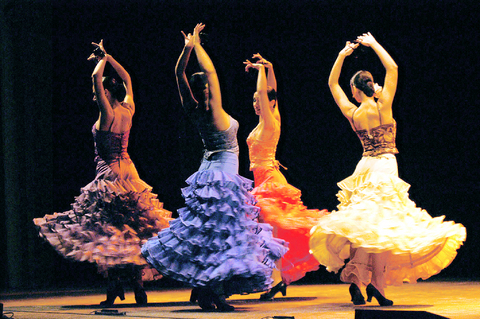Jose Greco Flamenco Dance Company wowed audiences on Friday night at the National Theater with shouting, leaping and a whole lot of stomping as they kicked off a weekend set of performances in Taipei with very energetic heels following a week-long tour of the island.
The first half of the show featured an anthology of Spanish dance.

Most of the pieces were ballet-inspired folk dances accompanied by the kind of canned orchestral music you might hear at the big top. Though the dances themselves were quite lively, perhaps more authentic music could have really brought out their folksy flavor.

PHOTOS COURTESY OF JOSE GRECO FLAMENCO DANCE COMPANY
Thankfully the live band did come out for Jose Greco's solo demonstration of the Serrana, a classic Andalusian form or palo of flamenco. All eyes were glued to Greco's fancy footwork from the first soulful strum of the guitar to Greco's final thundering stomp. With one cocky arm flung above his head, Greco gazed out over the awestruck audience. Applause erupted -- he had us just where he wanted us.
Possibly the only other highlight of the show's first half was when Carmela Greco, Jose's sister came out in a charcoal dress with a long ruffled train. Her dance, slow and stately, was punctuated by backward kicks to keep the dress' train in order, executed with the same haughtiness as if she were flinging long, flowing locks from her face.
The audience returned from intermission yearning for more of Jose Greco and that sultry guitar. They got it in the form of Los Tarantos, a Gitano Romeo and Juliet story adapted by Jose Greco to show off his and the company's skills. Greco played the pompous older peacock who claims the young beauty as his bride, and tries to tear her away from her lover. This was perfect for Greco, who used the vanity and machismo of his character as an excuse to treat the audience time and again to his jaw-dropping sequences of kicks and stomps.
Carmela, who played the matriarch, danced with the strength and sorrow of a woman weighed down by the world. Her slow, yet powerful movements provided a contrast to the wistful and frenetic dancing of the young lovers.
The confrontational scenes really brought out what might possibly be the true function of flamenco -- a glorified stomping contest.
These heated showdowns embodied the spirit of a genre that was born out of the pent-up frustration of persecuted peoples. The soulfulness of the Gitanos and the passion of the Moors combined centuries ago to produce the music and eventually the dance that became a symbol of Spanish national identity. On the stage Friday night, it became an expression of the fervent anger of desperate families.
Despite Greco's eye-popping moves, it was vocalist Gabarri Barrul Julio who really kept Los Tarantos going by inciting both the dancers and the audience to passion with his reverberating, melodic yells that sounded like an alternately furious and mournful call to prayer.
Meanwhile, the guitarists with their by turns gentle and violent strumming could have kept the audience rapt all by themselves.
By the end of it all, one was almost surprised that the dancers, musicians and their instruments didn't fall apart from exhaustion. But they were saving the best for the encore. As if the stage hadn't taken enough of a beating, the whole company came out stomping in unison.
Coaxed forward by Julio's impassioned hollering, each man took his turn freestyling with his best and wildest flamenco. Stomping their heels at lightning speed, kicking high in the air or shaking their entire bodies frenetically, these gentlemen were as much athletes as they were artists.
While female dancers in flowing skirts may be a symbol of the genre, the encore capped off a stirring demonstration of the fevered power that male dancers bring to Flamenco.
Jose Greco and his team spent enough energy out on that stage to keep the place heated up for a good chunk of the winter.

June 9 to June 15 A photo of two men riding trendy high-wheel Penny-Farthing bicycles past a Qing Dynasty gate aptly captures the essence of Taipei in 1897 — a newly colonized city on the cusp of great change. The Japanese began making significant modifications to the cityscape in 1899, tearing down Qing-era structures, widening boulevards and installing Western-style infrastructure and buildings. The photographer, Minosuke Imamura, only spent a year in Taiwan as a cartographer for the governor-general’s office, but he left behind a treasure trove of 130 images showing life at the onset of Japanese rule, spanning July 1897 to

In an interview posted online by United Daily News (UDN) on May 26, current Chinese Nationalist Party (KMT) Chairman Eric Chu (朱立倫) was asked about Taichung Mayor Lu Shiow-yen (盧秀燕) replacing him as party chair. Though not yet officially running, by the customs of Taiwan politics, Lu has been signalling she is both running for party chair and to be the party’s 2028 presidential candidate. She told an international media outlet that she was considering a run. She also gave a speech in Keelung on national priorities and foreign affairs. For details, see the May 23 edition of this column,

The Taiwan People’s Party (TPP) on May 18 held a rally in Taichung to mark the anniversary of President William Lai’s (賴清德) inauguration on May 20. The title of the rally could be loosely translated to “May 18 recall fraudulent goods” (518退貨ㄌㄨㄚˋ!). Unlike in English, where the terms are the same, “recall” (退貨) in this context refers to product recalls due to damaged, defective or fraudulent merchandise, not the political recalls (罷免) currently dominating the headlines. I attended the rally to determine if the impression was correct that the TPP under party Chairman Huang Kuo-Chang (黃國昌) had little of a

At Computex 2025, Nvidia CEO Jensen Huang (黃仁勳) urged the government to subsidize AI. “All schools in Taiwan must integrate AI into their curricula,” he declared. A few months earlier, he said, “If I were a student today, I’d immediately start using tools like ChatGPT, Gemini Pro and Grok to learn, write and accelerate my thinking.” Huang sees the AI-bullet train leaving the station. And as one of its drivers, he’s worried about youth not getting on board — bad for their careers, and bad for his workforce. As a semiconductor supply-chain powerhouse and AI hub wannabe, Taiwan is seeing